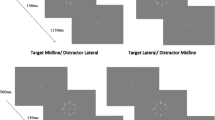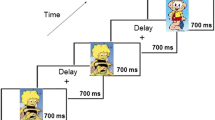Abstract
This paper studied whether abnormal P3 amplitudes in PDD are a corollary of abnormalities in ERP components related to selective attention in visual and auditory tasks. Furthermore, this study sought to clarify possible age differences in such abnormalities. Children with PDD showed smaller P3 amplitudes than controls, but no abnormalities in selective attention. Adolescents with PDD showed abnormal selective attention, as reflected by larger auditory Processing Negativity (PN) and visual N2b, but no P3 abnormalities. Dipole localizations revealed that the locations of PN generators in subjects with PDD differed from controls. It was concluded that the abnormalities in selective attention in adolescents with PDD have a normalizing effect on P3, and possibly act as a compensatory process.





Similar content being viewed by others
References
Alho, K., Teder, W., Lavikainen, J., & Naatanen, R. (1994). Strongly focused attention and auditory event-related potentials. Biological Psychology, 38, 73–90.
Allen, G., & Courchesne E. (2001). Attention function and dysfunction in autism. Frontiers in Bioscience, 6, D105–D119.
Allison, T., Hume, A. L., Wood, C. C., & Goff, W. R. (1984). Development and aging changes in somatosensory, auditory and visual evoked potentials. Electroencephalography and Clinical Neurophysiology, 58, 14–24.
American Psychiatric Association (1994). DSM-IV: Diagnostic and statistical manual of mental disorders. Arlington: American Psychiatric Press.
Bruneau, N., Roux, S., Adrien, J. L., & Barthelemy, C. (1999). Auditory associative cortex dysfunction in children with autism: Evidence from late auditory evoked potentials (N1 wave-T complex). Clinical Neurophysiology, 110, 1927–1934.
Buchwald, J. S., Erwin, R., Van Lancker, D., Guthrie, D., Schwafel, J., & Tanguay, P. (1992). Midlatency auditory evoked responses: P1 abnormalities in adult autistic subjects. Electroencephalography and Clinical Neurophysiology, 84, 164–171.
Ciaranello, A. L., & Ciaranello, R. D. (1995). The neurobiology of infantile autism. Annual Review of Neuroscience, 18, 101–128.
Ciesielski, K. T., Courchesne, E., & Elmasian, R. (1990). Effects of focused selective attention tasks on event-related potentials in autistic and normal individuals. Electroencephalography and Clinical Neurophysiology, 75, 207–220.
Ciesielski, K. T., Knight, J. E., Prince, R. J., Harris, R. J., & Handmaker, S. D. (1995). Event-related potentials in cross-modal divided attention in autism. Neuropsychologia, 33, 225–246.
Courchesne, E. (1987). A neurophysiological view of autism. In E. Schopler & G. B. Mesibov (Eds.), Neurobiological issues in autism (pp. 285–324). New York: Plenum Press.
Courchesne, E., Carper, R., & Akshoomoff, N. A. (2003). Evidence of brain overgrowth in the first year of life in autism. JAMA, 290, 337–344.
Courchesne, E., Karns, C. M., & Davis, H. R., et al. (2001). Unusual brain growth patterns in early life in patients with autistic disorder: An MRI study. Neurology, 57, 245–254.
Courchesne, E., Kilman, B. A., Galambos, R., & Lincoln, A. J. (1984). Autism: Processing of novel auditory information assessed by event-related brain potentials. Electroencephalography and Clinical Neurophysiology, 59, 238–248.
Courchesne, E., Lincoln, A. J., Kilman, B. A., Galambos, R. (1985). Event-related brain potential correlates of the processing of novel visual and auditory information in autism. Journal of Autism and Developmental Disorders, 15, 55–76.
Courchesne, E., Lincoln, A. J., Yeung-Courchesne, R., Elmasian, R., & Grillon, C. (1989). Pathophysiologic findings in nonretarded autism and receptive developmental language disorder. Journal of Autism and Developmental Disorders, 19, 1–17.
Dawson, G., Finley, C., Phillips, S., Galpert, L., & Lewy, A. (1988). Reduced P3 amplitude of the event-related brain potential: Its relationship to language ability in autism. Journal of Autism and Developmental Disorders, 18, 493–504.
Frith, U. (1997). The neurocognitive basis of autism. Trends in Cognitive Science, 1, 73–77.
Happe, F. (1999). Autism: Cognitive deficit or cognitive style? Trends in Cognitive Science, 3, 216–222.
Jolliffe, T., & Baron-Cohen, S. (1999). A test of central coherence theory: Linguistic processing in high-functioning adults with autism or Asperger syndrome: Is local coherence impaired? Cognition, 71, 149–185.
Jonkman, L. M., Kemner, C., & Verbaten, M. N., et al. (1997). Effects of methylphenidate on event-related potentials and performance of attention-deficit hyperactivity disorder children in auditory and visual selective attention tasks. Biological Psychiatry, 41, 690–702.
Kemner, C., Oranje, B., Verbaten, M. N., & Van Engeland, H. (2002). Normal P50 gating in children with autism. Journal of Clinical Psychiatry, 63, 214–217.
Kemner, C., Verbaten, M. N., Cuperus, J. M., Camfferman, G., & Van Engeland, H. (1994). Visual and somatosensory event-related brain potentials in autistic children and three different control groups. Electroencephalography and Clinical Neurophysiology, 92, 225–237.
Kemner, C., Verbaten, M. N., Cuperus, J. M., Camfferman, G., & Van Engeland, H. (1995). Auditory event-related brain potentials in autistic children and three different control groups. Biological Psychiatry, 38, 150–165.
Kenemans, J. L., Lijffijt, M., Camfferman, G., Verbaten, M. N. (2002). Split-second sequential selective activation in human secondary visual cortex. Journal of Cognitive Neuroscience, 14, 48–61.
Kenemans, J. L., Molenaar, P. C., Verbaten, M. N., & Slangen, J. L. (1991). Removal of the ocular artifact from the EEG: A comparison of time and frequency domain methods with simulated and real data. Psychophysiology, 28, 114–121.
Lincoln, A. J., Courchesne, E., Harms, L., & Allen, M. (1993). Contextual probability evaluation in autistic, receptive developmental language disorder, and control children: Event-related brain potential evidence. Journal of Autism and Developmental Disorders, 23, 37–58.
Lord, C., & Risi, S. (1996). Frameworks and methods in diagnosing autism spectrum disorders. Mental Retardation and Developmental Disabilities Research Reviews, 4, 90–96.
Lord, C., Rutter, M., & Le Couteur, A. (1994). Autism Diagnostic Interview – Revised: A revised version of a diagnostic interview for caregivers of individuals with possible pervasive developmental disorders. Journal of Autism and Developmental Disorders, 24, 659–685.
Luck, S. J., Woodman, G. F., & Vogel, E. K. (2000). Event-related potential studies of attention. Trends in Cognitive Science, 4, 432–440.
Muller, R., Pierce, K., Ambrose, J. B., Allen, G., & Courchesne, E. (2001). Atypical patterns of cerebral motor activation in autism: A functional magnetic resonance study. Biological Psychiatry, 49, 665–676.
Noterdaeme, M., Amorosa, H., Mildenberger, K., Sitter, S., Minow, F. (2001). Evaluation of attention problems in children with autism and children with a specific language disorder. European Child and Adolescent Psychiatry, 10, 58–66.
Novick, B., Kurtzberg, D., & Vaughn, H. G. (1979). An electrophysiologic indication of defective information storage in childhood autism. Psychiatry Research, 1, 101–108.
O’Neill, M., & Jones, R. S. (1997). Sensory-perceptual abnormalities in autism: A case for more research? Journal of Autism and Developmental Disorders, 27, 283–293.
Onofrj, M., Thomas, A., Iacono, D., D’Andreamatteo, G., & Paci, C. (2001). Age-related changes of evoked potentials. Neurophysiologie Clinique, 31, 83–103.
Ozonoff, S., Strayer, D. L., McMahon, W. M., & Filloux, F. (1994). Executive function abilities in autism and Tourette syndrome: An information processing approach. Journal of Child Psychology and Psychiatry, 35, 1015–1032.
Piven, J. (1997). The biological basis of autism. Current Opinion in Neurobiology, 7, 708–712.
Plaisted, K., Swettenham, J., & Rees, L. (1999). Children with autism show local precedence in a divided attention task and global precedence in a selective attention task. Journal of Child Psychology and Psychiatry, 40, 733–742.
Polich, J. (1998). P300 clinical utility and control of variability. Journal of Clinical Neurophysiology, 15, 14–33.
Rutter, M. (2000). Genetic studies of autism: From the 1970s into the millennium. Journal of Abnormal Child Psychology, 28, 3–14.
Thivierge, J., Bedard, C., Cote, R., & Maziade, M. (1990). Brainstem auditory evoked response and subcortical abnormalities in autism. American Journal of Psychiatry, 147, 1609–1613.
Verbaten, M. N., Roelofs, J. W., Van Engeland, H., Kenemans, J. K., & Slangen, J. L. (1991). Abnormal visual event-related potentials of autistic children. Journal of Autism and Developmental Disorders, 21, 449–470.
Woods, D. L., Knight, R. T., & Scabini, D. (1993). Anatomical substrates of auditory selective attention: Behavioral and electrophysiological effects of posterior association cortex lesions. Brain Research. Cognitive Brain Research, 1, 227–240.
Yeung-Courchesne, R., & Courchesne, E. (1997). From impasse to insight in autism research: From behavioral symptoms to biological explanations. Development and Psychopathology, 9, 389–419.
Author information
Authors and Affiliations
Corresponding author
Rights and permissions
About this article
Cite this article
Hoeksma, M.R., Kemner, C., Kenemans, J.L. et al. Abnormal Selective Attention Normalizes P3 Amplitudes in PDD. J Autism Dev Disord 36, 643–654 (2006). https://doi.org/10.1007/s10803-006-0102-5
Published:
Issue Date:
DOI: https://doi.org/10.1007/s10803-006-0102-5




